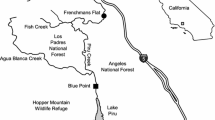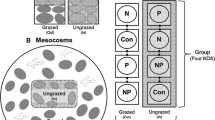Abstract
By shaping the architecture and taxonomic composition of periphyton, stream current may create periphytic mats on which some grazers can feed and forage more effectively than others. Current-mediated periphytic structure also has the potential to foster positive interactions among grazers if one grazer’s foraging facilitates another’s access to algal food. To examine the extent to which these indirect effects of current influenced periphytic removal and grazer interactions, we conducted a mesocosm experiment with two common grazers, the caddisfly (Trichoptera) Glossosoma verdona and the mayfly (Ephemeroptera) Drunella grandis. Periphyton was allowed to colonize ungrazed tiles for 30 d and assume its natural growth form under three ranges of near-bed current, “slow” (1–5 cm s−1), “medium” (15–20 cm s−1), and “fast” (30–40 cm s−1). Tiles were then exposed to the two grazer species at five densities. A streambed survey quantified Glossosoma and Drunella distributions in relation to near-bed current and periphytic structure (i.e., diatom films vs. filamentous mats) in the Colorado River. After 22 days of grazing, periphytic removal by Glossosoma was influenced by near-bed current and attendant periphytic structure. In slow current, where senescent Ulothrix filaments were abundant, increased Glossosoma density was correlated with an increase in periphyton biomass. Larvae became entangled and immobilized by the diffuse and senescent Ulothrix mat that characterized slow velocity, and Glossosoma mortality and weight loss was greatest in this treatment. By contrast, Drunella reduced periphyton across all density and current treatments. Drunella density correlated with increased Glossosoma survivorship and weight gain in slow current. The driving mechanism for this facilitation appeared to be removal of entangling overstory filaments by Drunella. The streambed survey showed that Glossosoma were negatively associated with filamentous mats, lending support to the hypothesis that clearing action by Drunella in the slow current/senescent Ulothrix treatment facilitated Glossosoma growth and survival. Our study helps underscore the importance of evaluating species interactions over ranges of abiotic conditions and consumer pressure to understand the patterns and processes shaping benthic communities.



Similar content being viewed by others
References
American public health association (1992) Standard methods for the examination of water and waste water. 18th (Ed.) American Public Health Association, Washington, DC
Botts PS (1993) The Impact of small chironomid grazers on epiphytic algal abundance and dispersion. Freshwater Biol 30:25–33
Bruno JF, Stachowicz JJ, Bertness MD (2003) Inclusion of facilitation into ecological theory. Trends Ecol Evol 18:119–125
Cardinale BJ, Palmer MA, Collins SL (2002) Species diversity enhances ecosystem functioning through interspecific facilitation. Nature 415:426–429
Colon-Gaud C, Whiles MR, Brenes R, Kilham SS, Lips KR, Pringle CM, Connelly S, Peterson SD (2010) Potential functional redundancy and resource facilitation between tadpoles and insect grazers in tropical headwater streams. Freshwater Biol 55:2077–2088. doi:10.1111/j.1365-2427.2010.02464.x
Dahl J, Peckarsky BL (2002) Induced morphological defenses in the wild: Predator effects on a mayfly, Drunella coloradensis. Ecology 83:1620–1634
Darcy-Hall TL, Hall SR (2008) Linking limitation to species composition: importance of inter- and intra-specific variation in grazing resistance. Oecologia 155:797–808. doi:10.1007/s00442-007-0948-z
Dodds WK, Biggs BJF (2002) Water velocity attenuation by stream periphyton and macrophytes in relation to growth form and architecture. J N Am Benthol Soc 21:2–15. doi:10.2307/1468295
Dudley TL (1992) Beneficial effects of herbivores on stream macroalgae via epiphyte removal. Oikos 65:121–127. doi:10.2307/3544894
Geddes P, Trexler JC (2003) Uncoupling of omnivore-mediated positive and negative effects on periphyton mats. Oecologia 136:585–595
Halpern BS, Silliman BR, Olden JD, Bruno JP, Bertness MD (2007) Incorporating positive interactions in aquatic restoration and conservation. Front Ecol Environ 5:153–160
Hart DD, Finelli CM (1999) Physical-biological coupling in streams: The pervasive effects of flow on benthic organisms. Ann Rev Ecol Syst 30:363–395
Hertonsson P, Abjornsson K, Bronmark C (2008) Competition and facilitation within and between a snail and a mayfly larva and the effect on the grazing process. Aquat Ecol 42:669–677. doi:10.1007/s10452-007-9129-8
Holomuzki JR, Biggs BJF (2000) Taxon-specific responses to high-flow disturbance in streams: implications for population persistence. J N Am Benthol Soc 19:670–679
Holomuzki JR, Feminella JW, Power ME (2010) Biotic interactions in freshwater benthic habitats. J N Am Benthol Soc 29:220–244. doi:10.1899/08-044.1
Hondzo M, Wang H (2002) Effects of turbulence on growth and metabolism of periphyton in a laboratory flume. Water Resour Res 38:1277. doi:10.1029/2002wr001409
Hoover TM, Richardson JS (2010) Does water velocity influence optimal escape behaviors in stream insects? Behav Ecol 21:242–249. doi:10.1093/beheco/arp182
Katano I, Mitsuhashi H, Isobe Y, Sato H, Oishi T (2005) Reach-scale distribution dynamics of a grazing stream insect, Micrasema quadriloba Martynov (Brachycentridae, Trichoptera), in relation to current velocity and periphyton abundance. Zool Sci 22:853–860. doi:10.2108/zsj.22.853
Katano I, Mitsuhashi H, Isobe Y, Sato H, Oishi T (2007) Group size of feeding stream case-bearing caddisfly grazers and resource abundance. Basic Appl Ecol 8:269–279. doi:10.1016/j.baae.2006.03.001
Lancaster J, Downes BJ (2010) Linking the hydraulic world of individual organisms to ecological processes: putting ecology into ecohydraulics. River Res Appl 26:385–403. doi:10.1002/rra.1274
Lancaster J, Buffin-Belanger T, Reid I, Rice S (2006) Flow- and substratum-mediated movement by a stream insect. Freshwater Biol 51:1053–1069. doi:10.1111/j.1365-2427.2006.01554.x
Larned ST, Nikora VI, Biggs BJF (2004) Mass-transfer-limited nitrogen and phosphorus uptake by stream periphyton: a conceptual model and experimental evidence. Limnol Oceanogr 49:1992–2000
Larson CA, Passy SI (2012) Taxonomic and functional composition of the algal benthos exhibits similar successional trends in response to nutrient supply and current velocity. FEMS Microbiol Ecol 80:352–362
Lee CT, Miller TEX, Inouye BD (2011) Consumer effects on the vital rates of their resource can determine the outcome of competition between consumers. Am Nat 178:452–463. doi:10.1086/661986
Liess A, Haglund AL (2007) Periphyton responds differentially to nutrients recycled in dissolved or faecal pellet form by the snail grazer Theodoxus fluviatilis. Freshwater Biol 52:1997–2008
McNeely C, Finlay JC, Power ME (2007) Grazer traits, competition, and carbon sources to a headwater-stream food web. Ecology 88:391–401
Meissner K, Juntunen A, Malmqvist B, Muotka T (2009) Predator-prey interactions in a variable environment: responses of a caddis larva and its blackfly prey to variations in stream flow. Ann Zool Fenn 46:193–204
Merritt RW, Cummins KW (1996) An introduction to the aquatic insects of North America, 3rd edn. Kendal/Hunt Publishing Co., Dubuque
Merten EC, Hintz WD, Lightbody AF, Wellnitz T (2010) Macroinvertebrate grazers, current velocity, and bedload transport rate influence periphytic accrual in a field-scale experimental stream. Hydrobiologia 652:179–184. doi:10.1007/s10750-010-0329-1
Monroe JB, Poff NLR, Thorp RA (2005) Natural history of a retreat-building midge, Pagastia partica, in a regulated reach of the upper Colorado River. West N Am Naturalist 65:451–461
Murdock JN, Dodds WK, Gido KB, Whiles MR (2011) Dynamic influences of nutrients and grazing fish on periphyton during recovery from flood. J N Am Benthol Soc 30:331–345. doi:10.1899/10-039.1
Opsahl R, Wellnitz T, Poff NL (2003) Interactions of current velocity and herbivory in regulating stream algae: an in situ electrical exclusion. Hydrobiologia 499:135–145
Passy SI (2001) Spatial paradigms of lotic diatom distribution: a landscape ecology perspective. J Phycol 37:370–378
Poff NL, Ward JV (1992) Heterogeneous currents and algal resources mediate in situ foraging activity of a mobile stream grazer. Oikos 65:465–478
Poff NL, Wellnitz T, Monroe JB (2003) Redundancy among three herbivorous insects across an experimental current velocity gradient. Oecologia 134:262–269
Power ME (1991) Shifts in the effects of tuft-weaving midges on filamentous algae. Am Mid Nat 125:275–285
Reid MA, Thoms MC, Dyer FJ (2006) Effects of spatial and temporal variation in hydraulic conditions on metabolism in cobble biofilm communities in an Australian upland stream. J N Am Benthol Soc 25:756–767
Rober AR, Wyatt KH, Stevenson RJ (2011) Regulation of algal structure and function by nutrients and grazing in a boreal wetland. J N Am Benthol Soc 30:787–796. doi:10.1899/10-166.1
Rosemond AD, Brawley SH (1996) Species-specific characteristics explain the persistence of Stigeoclonium tenue (Chlorophyta) in a woodland stream. J Phycol 32:54–63
Scrimgeour GJ, Culp JM, Bothwell ML, Wrona FJ, McKee MH (1991) Mechanisms of algal patch depletion: importance of consumptive and non-consumptive losses in mayfly-diatom systems. Oecologia 85:343–348
Syrovatka V, Schenkova J, Brabec K (2009) The distribution of chironomid larvae and oligochaetes within a stony-bottomed river stretch: the role of substrate and hydraulic characteristics. Fund Appl Limnol 174:43–62. doi:10.1127/1863-9135/2009/0174-0043
Vaughn CC, Spooner DE, Galbraith HS (2007) Context-dependent species identity effects within a functional group of filter-feeding bivalves. Ecology 88:1654–1662
Villanueva VD, Albarino R, Modenutti B (2004) Grazing impact of two aquatic invertebrates on periphyton from an Andean-Patagonian stream. Arch Hydrobiol 159:455–471
Wellnitz T, Poff NL (2006) Herbivory, current velocity and algal regrowth: how does periphyton grow when the grazers have gone? Freshwat Biol 51:2114–2123
Wellnitz T, Rader RB (2003) Mechanisms influencing community composition and succession in mountain stream periphyton: Interactions between scouring history, grazing, and irradiance. J N Am Benthol Soc 22:528–541
Wellnitz TA, Ward JV (1998) Does light intensity modify the effect mayfly grazers have on periphyton? Freshwat Biol 39:135–149
Wellnitz TA, Poff NL, Cosyleon G, Steury B (2001) Current velocity and spatial scale as determinants of the distribution and abundance of two rheophilic herbivorous insects. Landscape Ecol 16:111–120
Wilson WG, Osenberg CW, Schmitt RJ, Nisbet RM (1999) Complementary foraging behaviors allow coexistence of two consumers. Ecology 80:2358–2372
Acknowledgments
The authors wish to thank the Ouray Ranch and the Tillotson family for allowing us access to the upper Colorado River and acknowledge undergraduates Rebecca Buchholz, Dana Franz, Jeremy Monroe, Therese Tepe, and Trina Terrell for their assistance with the project. Undergraduate funding came from NSF’s Research Experience for Undergraduates and the Hughes Undergraduate Research Scholars program. Kim Urata volunteered help, assisted in construction of the “bunkhouse” at the site, and commented on early drafts of this manuscript. The research was funded by NSF grants DEB-00-75352 and CAREER DEB-06-42512.
Author information
Authors and Affiliations
Corresponding author
Additional information
Handling Editor: Michael T. Monaghan.
Rights and permissions
About this article
Cite this article
Wellnitz, T., LeRoy Poff, N. Current-mediated periphytic structure modifies grazer interactions and algal removal. Aquat Ecol 46, 521–530 (2012). https://doi.org/10.1007/s10452-012-9419-7
Received:
Accepted:
Published:
Issue Date:
DOI: https://doi.org/10.1007/s10452-012-9419-7




